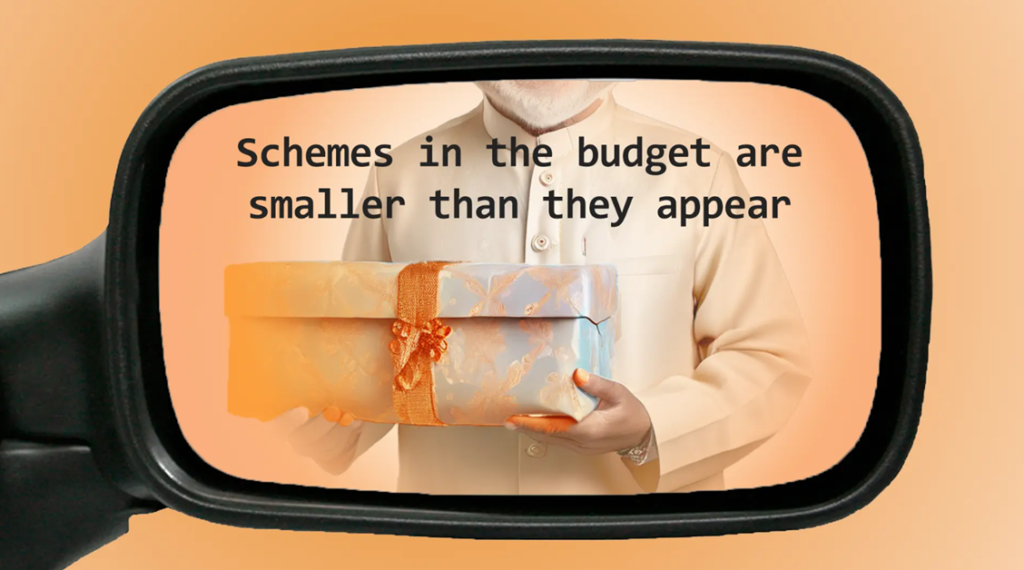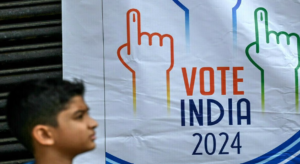Five years ago, the Narendra Modi government grabbed headlines with a budgetary commitment.
“The Government of India has decided to extend the pension benefit to about three crore retail traders and small shopkeepers,” said Finance Minister Nirmala Sitharaman in her maiden budget speech in July 2019.
As she announced the name of the scheme, Pradhan Mantri Karam Yogi Maan Dhan, amid the celebratory thumping in the House, the camera panned to Prime Minister Narendra Modi whose government pledged to spend Rs 750 crore in the first year of the scheme that promised a monthly pension of Rs 3,000.
However, as the attention faded, the commitment too died. In its first year, the government spent only Rs 155.9 crore, leaving a staggering funding gap of Rs 594 crore.
Over the next three years, spending projections plummeted to inconsequential sums. In the previous fiscal, a trifling Rs 3 crore was allotted, of which a mere Rs 10 lakh was spent for the programme, according to the latest budget data. Over a period of five years since its launch, the government promised to spend Rs 1,133 crore but actually allotted a measly Rs 162 crore – just 14% of the promised amount. According to official data, the scheme had just over 50,000 takers till January 2023.
In March 2023, the Parliamentary Standing Committee asked the government why the pension scheme failed. The government said this pension scheme clashed with another scheme with a similar sounding name.
According to the government, people mixed up Pradhan Mantri Karam Yogi Maan Dhan with another pension scheme called Pradhan Mantri Shram Yogi Maan Dhan launched just four months ahead of it, a rare admission of lack of imagination in naming new pan-India projects while attempting to deflect questions on government failure.
Pradhan Mantri Shram Yogi Maan Dhan was to potentially cover 42 crore unorganised sector workers. But this pension scheme too had failed, documents show. It had covered only 43 lakh of the 42 crore potential beneficiaries in three years since its launch.
When the Parliamentary Standing Committee questioned the government, it passed part of the blame to a third pension scheme of an older vintage — Atal Pension Yojana launched in 2015 for unorganised sector workers. This scheme had already in its scope those being targeted by the two pension schemes that came after it.
The Atal Pension Yojana also has a dubious record. Independent research, and investigation by The Reporters’ Collective showed that banks were forcefully enrolling citizens in the Atal Pension Yojana without their permission. This sparked intense criticism that the government was artificially inflating the number of enrollments to falsely showcase the scheme’s success.
The government tasked a think tank to evaluate its pension schemes. The think tank, in its report, recommended discontinuing Shram Yogi Maan Dhan and merging it with Atal Pension Yojana. Additionally, the Ministry itself was mulling merging the shopkeepers’ pension scheme with the unorganised workers’ pension scheme.
The three pension schemes may have failed to varying degrees, but they symbolise Narendra Modi’s penchant for billboard governance – highly visible headline grabbing governance initiatives that’s propped up long enough to regale commoners’ memory but gets defunded once the white heat dies.
The Collective reviewed budgetary allocations to 906 central sector schemes that the Union government listed in its budgets over five years from FY 2019-2020 to FY 2023-24 to find out how much the Modi government spent on them. We found that the government underfunded 651 or 71.9% of the 906 schemes.
For one in every five schemes, the government spent half or lower than what it had promised.
Of all the budget cuts, the harshest cut was reserved for welfare schemes. At least 75% of the welfare schemes got less money than what the government had promised.
The next major area the government focused on cutting back funds promised in the budget were infrastructure schemes such as track renewals, roadways schemes, renewable energy grid. The government drew down fundings promised in the budget for nearly 73% of the infrastructure schemes in the total schemes reviewed.
Defence, industry and PSU-related schemes came third, fourth and fifth in terms of budget and spending mismatch. The Collective segregated schemes into these categories based on a general understanding since these are not officially defined terms. For many schemes, the categories may overlap.
When the government eviscerates welfare schemes and draws down infrastructure funds, how does it still manage to set the perception that it has been constantly innovating, crafting new policies and doing more?
One trick up the government’s sleeve is to rebrand, rename, repackage and rebuild existing schemes, some of them decades-old, with some tweaks.
For example, The Collective’s previous investigation had exposed how the government used the much-vaunted PM AASHA as a showhorse during elections. The government spent money on the AASHA scheme brought in to ensure minimum support price for pulses and oilseeds only around the 2019 and 2024 elections and not a single rupee in between. The scheme even made its way to the 2019 BJP Lok Sabha manifesto as one of the schemes responsible for doubling farmers’ incomes. The actual workhorse was an age-old direct procurement scheme from the UPA era that was dressed up as a new scheme under brand PM AASHA. By 2024 the BJP dropped the promise of doubling farmers’ incomes altogether from its manifesto.
While the majority of schemes fell short of promised allocations over the period of five years, the total actual expenditure of all 906 schemes is higher than the total budgeted estimates. Data shows there are two reasons for this: Firstly, government spending on Covid-related schemes was disproportionately higher than the budgeted estimates. This, however, does not absolve the government of poor spending since schemes remained underfunded before and after the pandemic.
Secondly, as reported previously, the government hiked spending on some welfare schemes in the run-up to the 2024 Lok Sabha elections after years of plummeting budgeted estimates.
Let’s look closely at central schemes that are funded entirely by the Union government and find out how they fared and whether the government spent as much as it said it would. We focused on the central sector schemes because the Union government is entirely responsible for their success or failure, unlike centrally sponsored schemes that are partly funded by the state governments.
Source: Union budgets, FY 2019-20 to FY 2023-24
(In 2021-22, National Fellowship for SCs was subsumed under SHREYAS)
Agriculture
Multiple schemes brought in to ensure doubling of farmers’ incomes, saw deep cuts and minimal spending compared with initial promises outlined in the budgets.
The Collective analysed one of these schemes, PM AASHA, in an earlier report. The crop price support scheme saw real spending only in the months around 2019 and 2024 Lok Sabha elections. Three years in between the two general elections, the government did not spend a single rupee on the scheme.
A second scheme, Pradhan Mantri Kisan Maan Dhan Yojana, is a small and marginal farmers’ pension scheme. Much like the Karam Yogi Maan Dhan and Shram Yogi Maan Dhan, this scheme too has seen poor enrolment. Since 2019, only 7.8% farmers have enrolled in the scheme that targeted 3 crore farmers. For all the years except FY 2023-24, the government spent less than what it had budgeted, data shows.
Worse, since the launch of a scheme for Formation and Promotion of 10,000 Farmer Producer Organisations in 2020, the government has spent far less than what it promised in all four years. The scheme aims to help farmers work together to up their bargaining power, reduce production cost, and make more money by selling their crops together.
Health
Around the time of the second deadly Covid-19 wave in 2021, the Union government announced the PM-Ayushman Bharat Health Infrastructure Mission, touted as India’s largest scheme for public health infrastructure since 2005. The scheme is run in partnership with the states, with some components run entirely by the Centre. To fulfil its end of the promise, the Union government planned to spend in 5 years over Rs 9,339 crore to set up, among other things, national institutions for critical care and strengthen disease research centres, but has only spent Rs 1,373 crore, or 14.7% of the planned amount even after 3 years.
Pension schemes
The government promised to spend Rs 750 crore on the PM Karam Yogi Maan Dhan, a pension scheme for small shopkeepers, in the first year of its inception in 2019. Two years later, reality emerged: The government had spent only 20.7% of the amount budgeted, with Rs 155.7 crore expenditure. Even in the latest financial year, the government claimed it would spend Rs 3 crore but spent only 3.3% of that.
In the government’s own words, multiple pension schemes clashed and undercut each other. For example, the PM Shram Yogi Maan Dhan, launched four months before the Karam Yogi Maan Dhan, saw the government spending just 58.6% of the amount promised in the latest fiscal. This is despite the Parliament Standing Committee on Labour pulling up the Ministry of Labour for slack coverage under the scheme.
Education
In its 2019 election manifesto, BJP promised Eklavya Model Residential Schools in blocks with over 50% Scheduled Tribes people. The school is meant to improve access to education for tribespeople’s children. The Ministry of Tribal Affairs aimed for 740 schools by 2025-26, achieving 54% of the target with 401 schools by December 2023.
Despite the slow pace, budget estimates didn’t see an uptick until the 2024 Lok Sabha election drew close. It promised to spend Rs 5,943 crore in 2023-2024 but has so far spent only 41.6% of the fund, despite criticism from the Parliament Standing Committee.
The Committee said it was “apprehensive” that the government will achieve the target by 2025-26 since it takes 2.5 years to build one such school. The committee noted the ministry didn’t utilise all the money it had.
Similarly, the government underfunded the National Fellowship for Scheduled Castes meant to provide opportunities for students from the Scheduled Castes to pursue higher education. The Parliament Standing Committee flagged it in December 2023.
Source: Ministry of Social Justice and Empowerment.
Data shows actual spending on the fellowship has been decreasing. While the government spent only 68% of the amount promised in the budget in 2019-20, by 2021-22 it had come down to 40%. Even the number of fellowships awarded saw a 30% drop in 2022-23 compared with 2018-19 even after including previous year’s backlogs.
Rural Economy
In her maiden budget speech, Finance Minister Nirmala Sitharaman outlined how the government would help develop 75,000 skilled rural entrepreneurs in agro-rural industry sectors through a scheme called ASPIRE. Over the next four financial years, the government committed to cumulatively spend Rs 137 crore. However, it has spent only Rs 31 crore in this period, that’s just 22.7% of the promised amount.
Alongside ASPIRE, Sitharaman mentioned SFURTI, a scheme for upgrading traditional industries. Spending on SFURTI steadily rose until 2022-23, when the government aimed for Rs 334 crore but only spent Rs 1.95 crore. Similarly, the following fiscal year, the government spent Rs 2.5 crore against a budget estimate of Rs 280 crore.
(Navya Asopa is an incoming master’s student at Columbia Journalism School, New York. Shreegireesh reports and writes on issues of economy and governance. Before joining the collective, he worked with Business Standard. Courtesy: The Reporters Collective, a group of like-minded Indian journalists who collaborate to report on stories that put the spotlight on those in power; and who shed light on how India’s political economy and governance functions.)




